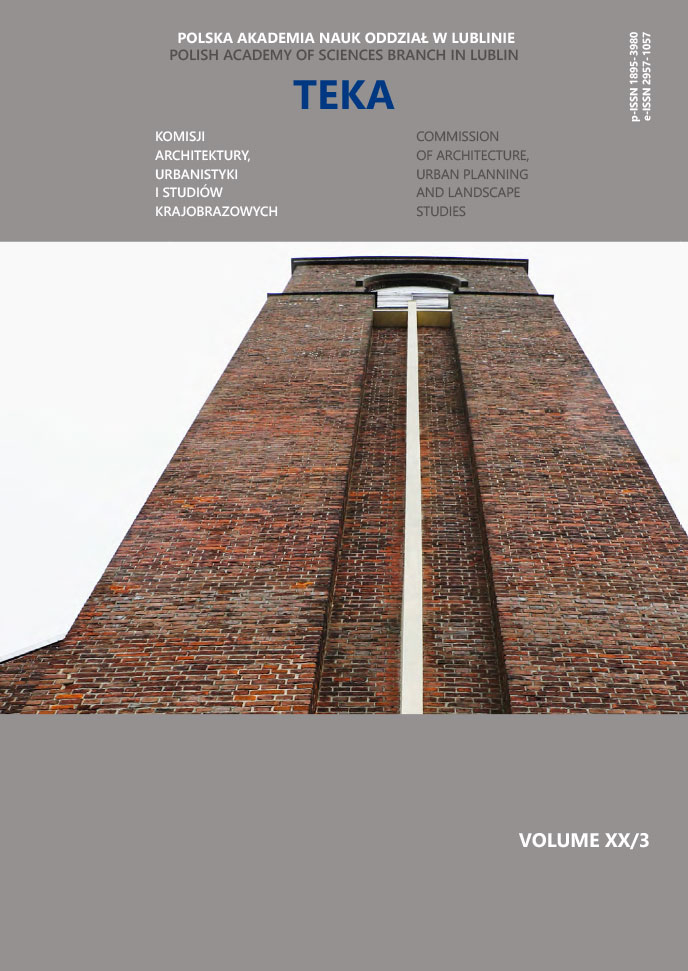Revitalization of the city’s riverside areas on the example of the urstromtal of the Malczewski Stream in Radom
Margot Dudkiewicz
margotdudkiewicz@o2.plDepartment of Ornamental Plants and Landscape Architecture, University of Life Sciences in Lublin (Poland)
https://orcid.org/0000-0002-3762-6192
Marek Dąbski
Department of Landscape Architecture Faculty of Horticulture and Landscape Architecture, University of Life Sciences in Lublin (Poland)
Sylwester Kaczmarski
Department of Landscape Architecture Faculty of Horticulture and Landscape Architecture, University of Life Sciences in Lublin (Poland)
Abstract
The area of the primeval valley of the Malczewski stream, located on the border of two blocks of flats inside the Radom housing estate Południe, has remained undeveloped for over twenty years. The existing stand is mainly self-seeding with the dominance of Salix alba (32%) and Populus tremula (16%). In addition, there are: Alnus incana (11%), Quercus rubra (10%), Acer negundo (7%) and others. There are no paved pedestrian routes. The conceptual design of the new development of the valley is a response to the needs of local residents. The project involves the creation of a square in the middle of the plot, with a focal point in the form of a fountain. Provides for the separation of an area with sports and recreational functions with a fitness and skate park, as well as two playgrounds for children. There is also a designated area for a dog paddock. A part of the park with a roofed gazebo and three paved squares with stone barbecues will serve as a recreation and leisure function for entire families. Referring to the names of the surrounding housing estate Południe and associations with the sun - the place was given the name of Sunny Park. The name of the park is underlined by the arrangement of alleys, reflecting the journey of the sun in the sky.
Supporting Agencies
Keywords:
city park, revitalization, Radom, housing estate PołudnieReferences
Bernat S. 2010. Doliny rzeczne i ich percepcja, Krajobrazy kulturowe dolin rzecznych, potencja i wykorzystanie. Prace Komisji Krajobrazu Kulturowego PTG 7: 167−178.
Google Scholar
Borcz Z. 2000. Elementy projektowania zieleni. Wyd. Akademii Rolniczej we Wrocławiu, Wrocław.
Google Scholar
Domańska J. 2012. Przyszłość dolin rzecznych w miastach. Czasopismo Techniczne sekcja Architektura 1: 131−139.
Google Scholar
Majdecki L. 2009. Historia ogrodów, Wyd. PWN, Warszawa.
Google Scholar
Malczyk T. 2005. Wytyczne do projektowania zieleni na terenach zabudowanych, Nysa.
Google Scholar
Nowakowski M. 1990. Centrum miasta. Wyd. Arkady Warszawa.
Google Scholar
Oleksiejuk E. 2005. Rola i funkcje zieleni w mieście [w:] Oleksiejuk E., Piotrowiak J. (red.), Zieleń miejska. Naturalne bogactwo miasta. Zasady gospodarowania i ochrona. Materiały konferencyjne, Wyd. Polskie Zrzeszenie Inżynierów i Techników Sanitarnych Oddział Toruń, Toruń: 111−117.
Google Scholar
Pancewicz A. 2004. Rzeka w krajobrazie miasta, Wydawnictwo Politechniki Śląskiej, Gliwice.
Google Scholar
Tołwiński T. 1963. Urbanistyka. Tom III Zieleń w urbanistyce, Państwowe Wydawnictwo Naukowe, Warszawa.
Google Scholar
Seneta W., Dolatowski J. 2012. Dendrologia. Wydawnictwo Naukowe PWN, Warszawa.
Google Scholar
Zachariasz A. 2012. Parki przyszłości – o różnych koncepcjach kształtowania terenów zieleni w miastach. Czasopismo Techniczne Architektura z. 1-A2: 455−462.
Google Scholar
Authors
Margot Dudkiewiczmargotdudkiewicz@o2.pl
Department of Ornamental Plants and Landscape Architecture, University of Life Sciences in Lublin Poland
https://orcid.org/0000-0002-3762-6192
Authors
Marek DąbskiDepartment of Landscape Architecture Faculty of Horticulture and Landscape Architecture, University of Life Sciences in Lublin Poland
Authors
Sylwester KaczmarskiDepartment of Landscape Architecture Faculty of Horticulture and Landscape Architecture, University of Life Sciences in Lublin Poland
Statistics
Abstract views: 149PDF downloads: 221
License

This work is licensed under a Creative Commons Attribution-ShareAlike 4.0 International License.




